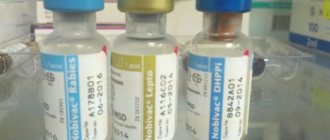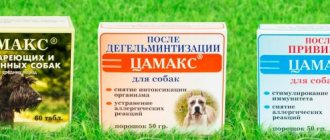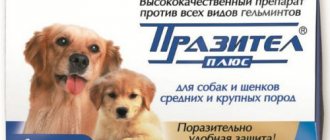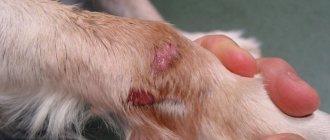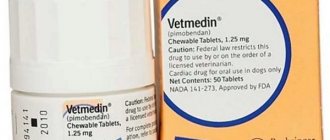In this article I will talk about the Nobivac Rabies vaccine. I will dwell on the components of the drug, indications and contraindications, and will discuss in detail the instructions for use and dosage. I will tell owners of pregnant animals how to vaccinate their pets with this drug.
Vaccination of animals with Nobivac Rabies
According to the instructions for use, a single vaccination at 12 weeks of age will protect both cats
, and dogs for a period of at least 3 years (In Russia, the vaccine is used at intervals of 12 months). If animals are vaccinated for the first time before 12 weeks of age, binding to maternal antibodies (reduced effectiveness) is possible and for this reason revaccination should be given at 12 weeks of age or older. However, Nobivac R rabies vaccination is part of a comprehensive vaccination programme. There are several alternatives. (See Vaccination Program for Dogs, See Vaccination Program for Cats).
Side effects and contraindications
Side effects include slight swelling at the injection site. Such swelling does not pose any danger and goes away on its own in 1-2 weeks.
It happens that a pet has an allergic reaction (as with any other drug). In this case, you need to consult a doctor.
Nobivac Rabies is a modern drug that is optimally safe for the animal. No cases of overdose were found.
The vaccine with this drug is contraindicated in weakened, sick or malnourished animals.
Special precautions when using the vaccine
- Allow Nobivac Rabies vaccine
to warm to ambient temperature (15-25 degrees C) before use. - Use sterile injection equipment.
- Shake before and during use.
- Special precautions for use on animals.
- Vaccinate only healthy animals.
- Special precautions should be taken by a veterinarian.
- Medicine only for animals.
Composition and description of the vaccine Nobivak Rabies
The rabies vaccine nobivac rabies is a suspension that contains inactivated, already killed virus rabies - rabies viruses.
In order for the body to intensively develop immunity to the substance, the vaccine contains an adjuvant.
It also includes some substances that help the body respond correctly to the injected serum.
Nobivac Rabies is made only from killed viruses. This eliminates even the slightest risk of infection with a weakened but live rabies virus. 1 package contains 10 bottles.
The appearance of the drug is a suspension, colored yellow or pink, of varying saturation. Supplied in transparent, glass bottles of 1 ml. The bottles are closed with rubber plugs and secured with aluminum tape.
Supplied in clear, glass bottles of 1 ml
Learn about essential drugs in animals
- Do puppies need to be vaccinated?
- Vaccination against rabies in cats
- Vaccination of small animals
- Kitten vaccination
- Why vaccinate dogs against rabies?
- What vaccinations do kittens get?
- What kind of drug is Nobivak Triquet Trio?
- Nobivac DHPPi for dogs
- What is the first vaccination for a puppy?
- Comprehensive vaccinations for cats
- What vaccinations do dogs have against ticks?
- What vaccinations are given to dogs and why?
- Why do cats need Ursofalk?
- Instructions for using serenia for animals
- Ursofalk in dogs
- Marfloxin for veterinary medicine
- Instructions for the use of serenia in dogs
- Graying in cats - Instructions
- Why is Heptor prescribed to a dog?
- Instructions for the use of lidocaine in dogs
- Heptor in cats
- Lidocaine for cats. Can cats use lidocaine?
- Heptral in dogs
- Can cats use marfloxin?
- Marfloxin for dogs (instructions for use)
- Heptral in cats (instructions for use, pharmacology
- Instructions for use of Dirofen for cats
- Instructions for using Vetom in cats
- Instructions: multifel for cats
- Use of fosprenil in cats
^Top
Storage conditions and shelf life
The vaccine must be stored and transported at a temperature of 2 to 8 degrees Celsius. Any increase or decrease in temperature that goes beyond these limits is unacceptable.
Shelf life at this temperature is 2 years.
The shelf life of the vaccine under normal home or outdoor conditions (outside the refrigerator) is no more than 2 hours.
If the temperature conditions are observed, the shelf life is 2 years.
Analogs
Despite the great demand for Nobivak, someone still has to buy its analogues. It’s just not always possible to find the right name in a veterinary pharmacy. You can replace one drug with a similar one if it contains the same viral cultures.
Several foreign vaccines are purchased, similar in strain to Nobivak. We are talking about Vanguard, Hexadog, Eurikan and Rabizin.
There are also Russian analogues that are just as effective in quality, but at a much lower cost. A number of items are also in demand. These are Hexakanivac, Dipentavak, Multikan.
Which is better for dogs: Nobivak or Eurikan?
"Eurikan" is the trade name of the French vaccine series. There are two varieties in the series, one with a strain of rabies, the second without it.
Eurikan DHPPI+2L is used for vaccination of adult dogs and puppies over 8 weeks of age. Revaccination is carried out with a composition containing the rabies virus. Next, the injection schedule is calculated simply: the drug is administered once a year.
This vaccination is also against a number of diseases; the list includes plague, enteritis, hepatitis, leptospirosis, parainfluenza, and rabies.
Eurikan or Nobivac - which is better? This question is often asked by lovers of barking four-legged animals. In fact, the answer is quite simple: Nobivak is not always available at the veterinary pharmacy, but Eurican is easier to get.
Rules of application
Vaccination with the Nobivak Rabies vaccine is allowed for cats from the age of 3 months, provided that they are healthy. Unlike the Nobivac triquet trio vaccine, pregnancy is not a contraindication to the use of Nobivac Rabies. If, due to an unfavorable epizootic situation, such a vaccination was done earlier, it must be repeated when the animal reaches the age of 3 months. Scheduled revaccination is carried out once every 3 years.
About two weeks before your cat is scheduled to be vaccinated against rabies, be sure to deworm your pet. The helminthic infestation present in the animal’s body greatly reduces the effect of the vaccine and prevents the formation of active immunity.
The Nobivac Rabies vaccine is administered intramuscularly or subcutaneously. The procedure is carried out as follows:
- The bottle with the drug is shaken vigorously until a homogeneous emulsion is obtained.
- Having bent the center of the aluminum cap, wipe the rubber stopper with alcohol.
- Having pierced the stopper of the bottle with a needle, transfer its contents into a syringe.
- The injection site is treated with alcohol.
- After removing the air from the syringe, the drug is injected into a retracted skin fold on the neck or a muscle located under the knee.
- The cat is kept under observation for 10-15 minutes.
The rabies vaccine Nobivak Rabies can be used by mixing it in a syringe in a 1:1 ratio with the leptospirosis vaccine Nobivak Lepto. The use of Nobivac Rabies with the Nobivac Tricat trio vaccine against viral rhinotracheitis, calicivirosis and panleukopenia is permitted provided that they are administered with different syringes.
Vaccinating your pet against rabies
Introduction.
Rabies (rabies) is a particularly dangerous (fatal, incurable) viral disease of warm-blooded animals (mammals, theoretically birds) and humans.
It is a natural focal disease, i.e. has permanent carriers (reservoir) in the form of wild predators (foxes, wolves, raccoons, bats, etc.), which may not get sick and keep the pathogen in an inactive form for many years. The rabies virus is transmitted by the bite or saliva of a sick animal coming into contact with damaged skin and mucous membranes. The virus infects the tissues of the nervous system, leading to irreversible changes and death. There is currently no cure for rabies. The only way to combat the disease now is prevention, which is based on the introduction of vaccines.
Legal aspects of vaccination
According to the veterinary legislation of the Russian Federation, a significant part of domestic animals must be vaccinated against rabies. Cows, sheep, pigs and horses are subject to vaccination. the STRICT OBLIGATION is relevant . Citizens also have a significant number of other animals, the specifics of keeping them are not clearly stated in the laws, but their vaccination against rabies seems completely logical. These are large cats (cougars, lynxes, caracals, etc.), dogs (wolves, wolfdogs), bears, raccoons, noses, raccoon dogs, ferrets and other representatives of mustelids (martens, minks, sables), primates, minipigs.
The issue of the need to vaccinate rabbits, rodents, marsupials, hedgehogs, civets, mongooses, bats (mergans, etc.) remains under discussion. There are currently no rabies vaccination requirements for these families. But the situation may change due to the large number of controversial situations in the case of bites of people by such animals, both when kept at home and when kept in pet stores and zoos. Birds and reptiles do not need to be vaccinated against rabies.
The authority to vaccinate domestic animals is given to veterinary specialists. If in rural areas this issue is supervised by the state veterinary service, then in large populated areas, due to the large number and diversity of pets, both representatives of government services and doctors of private veterinary clinics have the right to vaccinate dogs, cats and exotic patients against rabies.
Regarding vaccines
Currently, there are about a dozen different vaccines on the market, both domestic and imported. Moreover, in different regions and even in different settlements of one region one brand (or group of brands) may dominate, while in another there may be a completely different picture.
Basic rabies vaccines:
Rabican is a domestic vaccine, used mainly by the state veterinary service. Used for dogs, cats, cattle.
Rabix is a domestic vaccine for dogs and canines (Arctic foxes, foxes, etc.) from the manufacturer NARVAK.
Rabifel is a domestic vaccine for cats.
Nobivac Rabies is a Dutch vaccine. The instructions include dogs, cats, cattle, sheep, goats, horses, foxes, minks and ferrets. One of the most famous imported rabies vaccines.
Nobivac RL is a Dutch complex vaccine containing a component against rabies and leptospirosis. Suitable for dogs.
Rabisin is a French vaccine for vaccination of dogs and cats, ferrets, horses, cattle and sheep.
Defensor 3 is an American vaccine for dogs and cats.
mono is a French vaccine for dogs and cats against.
This list does not exhaust all vaccine options. But other drugs are very rare.
A logical question: “How to choose which vaccine to vaccinate your pet with?” Should I give preference to the cheaper domestic version (and which one of them) or choose the mass-produced Nobivak or should I still look for the rarer Defensor-3?
Unfortunately, the specificity of the use of any vaccine is the absence of any clinical manifestations of its (good) work. And the final result that can be measured (antibody titer to rabies) depends not only on the manufacturer of the administered biological product, but also on the response of the immune system of a particular organism to it. Determining the antibody titer is a rather lengthy, not universally available, and not at all cheap method of assessing the effect of vaccination (namely the effect of vaccination, not the quality of the vaccine) in a particular animal.
In such a situation, the choice always remains with the owner.
Regarding the timing of vaccination , most instructions state that the primary vaccination against rabies should be carried out when the puppy or kitten is at least 12 weeks old (about 3 months). There is no need to be vaccinated against this disease before this age! It is recommended to vaccinate animals once (domestic vaccines - twice!). The effect of administration of different vaccines (according to the instructions for them) varies greatly (from one to three years). But according to the requirements of the veterinary legislation of the Russian Federation, revaccination against rabies is required every year.
A very important note. The fact of vaccination must be recorded in the veterinary passport (certificate) of the animal and in the journal of the veterinary clinic that performed the manipulations. The entry in the passport must be certified by the signature of a veterinary specialist and the seal of the institution. Otherwise, the procedure performed is legally invalid.
What vaccines should I vaccinate other animals with?
No manufacturer (for objective reasons) produces vaccines only for raccoons or skunks or meerkats, and these animals are not mentioned in the instructions for the biological product. But they need to be vaccinated. In such a situation, veterinarians use rabies vaccines for dogs and cats. Many years of experience have shown that vaccines are well tolerated by other carnivorous (and not only) mammals and the percentage of any complications is no higher than when used by annotated animals.
What conclusion can be drawn from all this?
It's simple. Rabies is present in our lives. Once infected, there is no cure. Vaccines provide a very good preventive effect. By vaccinating an animal, you comply with the laws of the country, do not create problems for yourself when moving around the territory of the state with an animal, and protect yourself from claims in the event of conflict situations (bites, etc.). In addition, you are improving the epizootic and epidemiological situation in the country (as always, big things come from small actions). Your costs for carrying out preventive vaccination (finance, time) are insignificant, but they can save time, money, and sometimes lives (of a person or an animal) in case of contact with an infected animal.
What recommendation can we give? Of course it is obvious. Take one hour of your life, make an appointment at the veterinary clinic and vaccinate your animal against rabies.
Veterinarian Kazakov Artem Arkadyevich Veterinarian Pererva Lyudmila Viktorovna ed. 08.2020.



